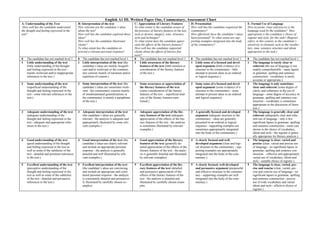
Day 2_Session II_Increasing rigor_writing
- 1. English A1 HL Written Paper One, Commentary, Assessment ChartA: Understanding of the Text How well has the candidate understood the thought and feeling expressed in the text?B: Interpretation of the textHow relevant are the candidate’s ideas about the text? How well has the candidate explored those ideas? How well has the candidate illustrated claims?To what extent has the candidate expressed a relevant personal response?C: Appreciation of Literary Features To what extent is the candidate aware of the presence of literary features in the text, such as diction, imagery, tone, structure, style and technique?To what extent does the candidate appreciate the effects of the literary features? How well has the candidate supported claims about the effects of literary features?D: Presentation How well has the candidate organized the commentary? How effectively have the candidate’s ideas been presented? To what extent are supporting examples integrated into the body of the commentary?E: Formal Use of LanguageHow accurate, clear and precise is the language used by the candidate? How appropriate is the candidate’s choice of register and style, for this task? (Register refers, in this context, to the candidate’s sensitivity to elements such as the vocabulary, tone, sentence structure and idiom appropriate to the task.)0The candidate has not reached level 1.0The candidate has not reached level 1.0The candidate has not reached level 1.0The candidate has not reached level 1.0The candidate has not reached level 1.1Little understanding of the text(little understanding of the thought and feeling expressed in the text - mainly irrelevant and/or inappropriate references to the text.)1Little interpretation of the text (the candidate’s ideas are mainly insignificant and/or irrelevant or the commentary consists mainly of narration and/or repetition of content.)1Little awareness of the literary features of the text (little mention or consideration of the literary features of the text.)1Little sense of a focused and developed argument (little evidence of a structure to the commentary - little attempt to present ideas in an ordered or logical sequence.)1The language is rarely clear or coherent (the use of language is not readily comprehensible - many lapses in grammar, spelling and sentence construction - vocabulary is rarely accurate or appropriate.)2Some understanding of the text(superficial understanding of the thought and feeling expressed in the text - some relevant references to the text.)2Some interpretation of the text (the candidate’s ideas are sometimes irrelevant - the commentary consists mainly of unsubstantiated generalizations or the commentary is mainly a paraphrase of the text.)2Some awareness or appreciation of the literary features of the text (some consideration of the literary features of the text - superficial analysis of the literary features mentioned.)2Some sense of a focused and developed argument (some evidence of a structure to the commentary - some attempt to present ideas in an ordered and logical sequence)2The language is only sometimes clear and coherent (some degree of clarity and coherence in the use of language - some degree of accuracy in grammar, spelling and sentence construction - vocabulary is sometimes appropriate to the discussion of literature.)3Adequate understanding of the text(adequate understanding of the thought and feeling expressed in the text - adequate and appropriate references to the text.)3Adequate interpretation of the text (the candidate’s ideas are generally relevant - the analysis is adequate and appropriately illustrated by some relevant examples.)3Adequate appreciation of the literary features of the text (adequate appreciation of the effects of the literary features of the text - the analysis is sometimes illustrated by relevant examples.)3A generally focused and developed argument (adequate structure to the commentary - ideas are generally presented in an ordered or logical sequence - supporting examples are sometimes appropriately integrated into the body of the commentary.)3The language is generally clear and coherent (adequately clear and coherent use of language - only a few significant lapses in grammar, spelling and sentence construction - some care shown in the choice of vocabulary, idiom and style - the register is generally appropriate for literary analysis.)4Good understanding of the text (good understanding of the thought and feeling expressed in the text as well as some of the subtleties of the text - detailed and pertinent references to the text.)4Good interpretation of the text (the candidate’s ideas are clearly relevant and include an appropriate personal response - the analysis is generally detailed and well illustrated by relevant examples.)4Good appreciation of the literary features of the text (generally detailed appreciation of the effects of the literary features of the text - the analysis is generally detailed and illustrated by relevant examples)4A clearly focused and well-developed argument (clear and logical structure to the commentary - supporting examples are appropriately integrated into the body of the commentary.)4The language is clear, varied and precise (clear, varied and precise use of language - no significant lapses in grammar, spelling and sentence construction - effective and appropriately varied use of vocabulary, idiom and style - suitable choice of register.)5Excellent understanding of the text (perceptive understanding of the thought and feeling expressed in the text as well as some of the subtleties of the text - detailed and persuasive references to the text.)5Excellent interpretation of the text (the candidate’s ideas are convincing and include an appropriate and considered personal response - the analysis is consistently detailed and persuasively illustrated by carefully chosen examples)5Excellent appreciation of the literary features of the text (detailed and persuasive appreciation of the effects of the literary features of the text - the analysis is detailed and illustrated by carefully chosen examples.5A clearly focused, well-developed and persuasive argument (purposeful and effective structure to the commentary - supporting examples are well integrated into the body of the commentary.)5The language is clear, varied, precise and concise (clear, varied, precise and concise use of language - no significant lapses in grammar, spelling and sentence construction - precise use of wide vocabulary and varied idiom and style - effective choice of register.)<br />
